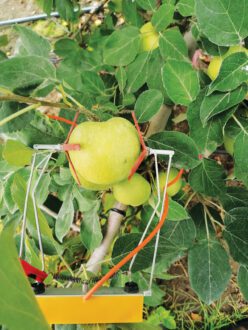Jul 10, 2023Sensors help trees tell growers when they are thirsty
The traditional method of using technology to alert growers of the need to irrigate involves soil-based sensors, which do well at relaying moisture data at a specific depth and location.
Dendrometers, which measure the expansion and contraction of fruit tree trunks and fruit growth when placed directly on apples or pears, were typically used in early season fruit growth forecasting to shed light on production. In recent years, however, dendrometers in Washington apple orchards have also been used to
indicate tree stress and the need for irrigation, said Lee Kalcsits, assistant professor of tree fruit physiology at Washington State University (WSU).


In January, Kalcsits and Victor Blanco, a postdoctoral researcher, ended a two-year study into different sensor technology to detect stress in Washington and apple and pear trees as a way to guide irrigation decisions.
“I think it’s difficult for growers now because there is a lot of technology available, and it’s really important that when growers adopt a technology that it truly leads to either a change in practice or a clear decision-making pathway,” Kalcsits said. “And if it doesn’t, then you really question what the value of these technologies are, because they are not cheap. Whatever technologies are adopted need to be directly for decision-making.”
The project involved using the sensors in a Grandview, Washington, Honeycrisp orchard that was dubbed the Smart Orchard project. This is a Washington Tree Fruit Research Commission funded effort with WSU researchers and technology companies testing various tech on the trees.
There are several ways to assess a tree’s water needs, Kalcsits said. Tracking soil moisture and water availability can help growers estimate demand. Ideally, directly measuring what a tree is experiencing inside its trunk allows it to communicate stress and the need for irrigation.
“We developed thresholds and models of how a tree responds to soil stress or the environmental stress, and the sensors would directly measure variables in the tree that indicated whether it was stressed or not,” he said.
Of particular interest in the study was the use of microchip tensiometers — microtensiometers — that are “plugged” into tree trunks and use microchips to detect stress triggered by low water content. The advantage of the trunk microtensiometer’s pressure chip is that it directly monitors plant stress-related tension, whereas dendrometers measure it indirectly. In high-stress situations, the relationship between the dendrometers and the information they receive from the trunk can break down, Kalcsits said.


A drawback to the microtensiometers was the need for the trunk to be at least two inches in diameter, he said, which prohibited using them during critical early stages of growth. Since the project started, however, the company that makes the sensors, FloraPulse, has introduced a smaller unit that can be used for trunks under two inches. According to FloraPulse, the technology has been used to chart irrigation needs of more than a dozen crops, including almonds, grapes, oranges, peaches, plums, cherries and apricots.
“Eliminating water stress is really important for establishing that early canopy growth and any availability to monitor that, to optimize water delivery to those young trees, is really important, so this would give the opportunity for that,” Kalcsits said.
Although there are no current plans for a study on microtensiometer use in younger trees, Kalcsits said it’s a possibility.
“A lot of growers are still using soil sensors in their decisionmaking and I think, for the most part, it works quite well, but there are cases where it makes sense to optimize and move to plant-based sensors, and some growers are doing that,” he said. “I regularly get questions on interpreting that data and helping them make those decisions a little bit better.”
— Chris Koger, managing editor














